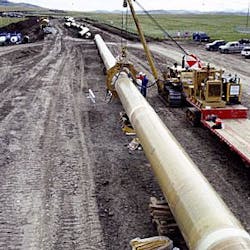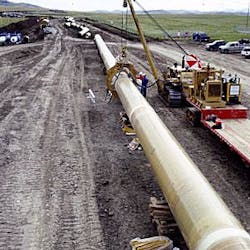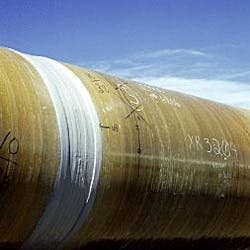Field tests in the last 2 years by TransCanada PipeLines Inc., Calgary, have shown the practicality of installing composite-reinforced line pipe (CRLP) as an alternative to newly developed but more expensive high-strength line pipe.
In September 2002, NCF Industries Inc., TransCanada, and CRC-Evans Pipeline International, successfully joined seven sections of a 40-ft long CRLP on the 15-mile Saratoga section of the Western Alberta system mainline expansion (Fig. 1), according to an account jointly prepared by these and other companies involved and supplied to Oil & Gas Journal.
Using relatively simple equipment and assisted by pipeline contractor Marine Pipeline Construction of Canada Co., Edmonton, two technicians composite-coated six weld-area joints of the 48-in. OD, 0.461-in. WT, X-70 steel pipe reinforced with an outer wrap of isopolyester resin–glass fiber composite (Fig. 2). The installed pipe is now part of a natural gas pipeline operating at 960 psi with future capability to operate at 1,260 psi.
null
Trends
The general trend in the natural gas pipeline transmission industry has been toward high-pressure pipelines using higher-strength steels. As strength has been increased, however, so have issues of weldability, fracture control, and cost.
TransCanada has been developing and testing the hybrid product, CRLP, since 1996 to address these issues. CRLP's outer wrap of high performance, composite material reinforces a high strength, low-alloy steel pipe. This is a patented technology developed by NCF Industries and licensed in Canada to TransCanada.
The success of the installation, said the companies, helps to demonstrate that CRLP is a viable solution in real-world applications. As an alternative to more expensive solutions for high pressure, high-throughput pipelines—such as thicker-walled X-100 steel pipe—the benefits of CRLP include lower material costs, lower transportation costs, faster installation time, increased corrosion resistance, and reduced risk of propagating failures.
From the beginning
Preparation for the field test actually started in California at NCF Industries. NCF received the seven sections of IPSCO Inc.-made steel pipe in its winding facility and wrapped each with an isopolyester resin–glass fiber composite. At the ends of each pipe, 6 in. of steel remained exposed so that the sections could be welded together in the field.
The composite used to coat the steel pipe is the result of collaboration among NCF Industries; TransCanada; BP; AOC LLC, Collierville, Tenn.; PPG Industries, Pittsburgh; and Composites One, Arlington Heights, Ill.
AOC supplies the heat-activated thermoset resin, made with purified isophthalic acid from BP. Designed specifically for TransCanada by AOC, with technical support from BP, the isopolyester resin offers high mechanical and corrosion-resistance properties and resists distortion under high temperatures.
The glass fiber from PPG is e-glass, originally developed for electrical insulators and capacitors and now widely used in composite applications. The tows, or bundles of e-glass fibers, have high tensile strength, enhanced with a surface sizing that coats and protects the individual fibers. PPG supplied the fiber to NCF as bundles of tows, called "rovings."
To wrap the steel pipe, the glass fiber roving is impregnated with the isopolyester resin. This composite material is then wrapped around the pipe. A heat-activated process initiates the resin curing.
Once cured, the composite wrapping will not distort, even under high temperatures. The glass fiber rovings, firmly set in the cured isopolyester, add hoop strength to the pipe.
Although the test sections were coated in California, the wrapping process is portable, allowing it to be incorporated into any pipe coating facility in the world, said the companies. The portability of the design can help minimize transportation costs from plant to field and make it possible to take advantage of locally produced steel.
The finished product is a conventional steel pipe reinforced with glass fiber rovings and isopolyester. The isopolyester also protects against corrosion of the steel layer of the pipe (Fig. 3).
null
Weld to wrap
NCF shipped the seven pipe sections to Canada, along with glass fiber roving, supplied by Composites One, pre-impregnated with the isopolyester resin. The installation process involves first welding the exposed steel ends of the pipe together and then field wrapping the exposed weld area with the "pre-preg" composite joint wrap.
The result is a continuous composite-reinforced system. CRC-Evans Pipeline International, Tulsa, manufactured the portable field-wrapping machine and supplied a technician to assist in the field application.
In less than 2 hr, NCF trained two technicians from TransCanada and CRC-Evans to use the proprietary wrapping process and the equipment provided.
Using the wrapping equipment, they wound the pre-preg around the joint several times to a thickness of approximately 1.5 in. They followed this with a high-strength plastic film to compress the composite.
A dielectric heater built onto the equipment heated the wrapping to about 250° F., at which point the exothermic cure continued on its own to about 300° F.
An insulating blanket can be used to hold in the heat under cold conditions and ensure that the cure is complete. The cure takes about 10 to 20 min, said the companies.
For this first trial of a new process in the field, the joining of the sections—from the wrapping process through the cure—took on average 20 min/joint. With improvements and modifications that come with refinement of any new technique, this time is expected to drop even further.
Conventional steel pipelines are welded together and then a corrosion coating is applied to the weld area. Because CRLP uses less steel, welding time is reduced by up to a 40%. The companies said that use of CRLP eliminates the need for the corrosion coating at the weld area because the composite provides better corrosion and abrasion resistance.
Once production models are produced and procedures modified, the CRLP joint-wrapping process should take the same amount of time as the corrosion coating process that it replaces.
Multiple material system
In its ongoing efforts to improve the economics of gas transport over long distances, TransCanada has considered many alternatives. CRLP is proving to be ideally suited for the construction of high pressure, large-diameter pipelines operating at as much as 3,600 psi.
CRLP, a multiple material system, gives large-diameter, conventional steel pipe the strength needed for higher pressure pipeline applications, said the companies. It is not damaged by denting and gouging under simulated service conditions that would severely damage unwrapped steel pipes.
The layers of glass fibers in isopolyester resin have a tensile strength of 120,000 to 140,000 psi, making the composite layer about two times stronger than the underlying steel layer.
The result is a stronger pipe with the added corrosion protection of the composite layer.
High strength X-100 steel, another alternative to conventional steel, although a more expensive material, offers the cost advantages that can accrue from thinner, lighter weight pipe sections.
High-strength steels, however, often do not have the fracture-control capability required for high-pressure pipelines, said the companies, and an option is to wrap these higher strength steels with CRLP to provide fracture control and crack-arrest capabilities.
null
A priority for operators of high-pressure natural gas systems is safety and pipeline integrity. CRLP addresses these challenges.
Time-dependent failure modes such as general corrosion or stress corrosion cracking can, depending upon the size of the defect, result in a leak or rupture. CRLP provides a leak-without-burst mode of failure for these pipeline defects, which minimizes the probability of ignition, particularly for high pressure, large-diameter pipelines.
CRLP resists fracture propagation. NCF and TransCanada say they have conducted extensive tests demonstrating the ability to arrest propagating fracture velocities exceeding 1,000 fps. CRLP has been designed with a minimum factor of safety of two times maximum allowable operating pressure. Pipeline codes allow minimum safety factors of 1.4:1 MAOP.
Composite reinforcement allows the variables of pipe diameter, wall thickness, steel strength, and line pressure to be balanced in the way most suitable for a given situation to achieve a stronger, lighter, safer, more economical, more durable pipe for natural gas pipelines, the companies said.
Although bending the pipe was not required on this test section, TransCanada successfully bent 10 to 15 CRLP joints in a 1.5-mile installation of 24-in. diameter CRLP that was installed in northern Alberta in –25° C. temperatures in February of 2001.
Numbers
The companies claim the material costs alone with CRLP are 10 to 20% lower than for X-100 steel pipe of equal capacity. Additional financial benefits accrue from the lightweight, easy-to-join reinforced pipe with fracture control and arrest capabilities.
Each piece of composite reinforced pipe weighs approximately 10,000 lb, making it about 30 to 40% lighter than steel pipe with the same pressure rating, reducing transportation costs. The reduced weight also reduces the need for heavy equipment typically used in traditional stringing practices.
With CRLP, only the steel liner is welded, thus reducing the weld area by about 50%. Reduced thickness of the steel also adds to an overall reduction of welding time by 40%, reducing installation costs, said the companies.
The durability of CRLP and its ability to prevent catastrophic failures offer the potential to avoid the overwhelming devastation and costs associated with bursts and propagating failures. Tests conducted by the National Bureau of Standards conclude that CRLP is 20% lower in cost and consumes 40% less energy than conventional steel line pipe.
For the TransCanada application, the company estimates that overall pipeline project costs can be reduced by 4 to 12% with the use of CRLP compared to all-steel pipelines. Another added benefit of using CRLP is that it is reinforced on the outside of the pipe so that the ID is larger than the all-steel pipe size, providing up to 6% increase in volume throughput.




